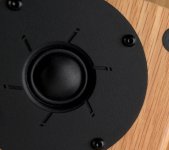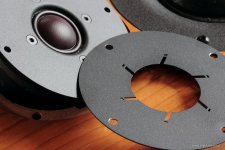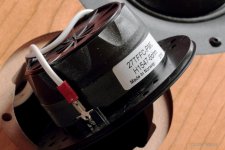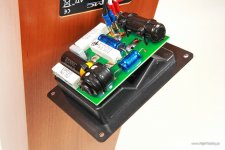Member
Joined 2009
Paid Member
Member
Joined 2009
Paid Member
Member
Joined 2009
Paid Member
Why PMC specifically, given that the majority of companies & DIY constructors do not use waveguides?
Because I own a pair of FB1's (from new) and I have been thinking of upgrading the tweeter for something a bit smoother - there's a breakup somewhere my ears don't like.
Fair enough, although driver resonances have nothing to do with waveguides. Or perhaps I should say 'a badly designed waveguide may cause additional resonances'. Be that as it may, upgrading the tweeter & filter design should be worthwhile if you're otherwise happy with them.
Because I own a pair of FB1's (from new) and I have been thinking of upgrading the tweeter for something a bit smoother - there's a breakup somewhere my ears don't like.
Sometimes the fault can be the woofer (breakup). Regardless It's very unlikely to be a problem with the actual tweeter and much more likely to be a problem with the crossover.
Member
Joined 2009
Paid Member
PMC did later modify the cross-over, they had a couple of models after the FB1, which was their first foray into this end of the market. In their later models they lowered the cross-over point which would have pushed the woofer breakup further into the noise. But in lowering the cross-over they also replaced the tweeter. The two are connected.
It looks quite doable to upgrade my original FB1 to a later iteration. Eventually they changed the TL design but I could upgrade to the version just before that. I think the sequence was FB1 to FB1+ and then to the FB1i. The FB1+ uses a silk dome tweeter from Vifa (same woofer), my speakers have a metal dome (one of them I think has a kiddie dent). The FB1+ kept the same XO as the FB1, at around 3kHz. The FB1i took it another step forward and lowered the XO to 2kHz with a Solonex soft dome tweeter. The FB1i is reported to be the best sounding of the three.
It looks quite doable to upgrade my original FB1 to a later iteration. Eventually they changed the TL design but I could upgrade to the version just before that. I think the sequence was FB1 to FB1+ and then to the FB1i. The FB1+ uses a silk dome tweeter from Vifa (same woofer), my speakers have a metal dome (one of them I think has a kiddie dent). The FB1+ kept the same XO as the FB1, at around 3kHz. The FB1i took it another step forward and lowered the XO to 2kHz with a Solonex soft dome tweeter. The FB1i is reported to be the best sounding of the three.
Last edited:
Member
Joined 2009
Paid Member
It looks as if they (PMC) have made some kind of custom faceplate that they mount over the top of the tweeter. It is marketing BS, something to cover up the identity or mounting hardware, or some attempt at controlling diffraction effects - I don't know.
Attachments
Member
Joined 2009
Paid Member
Surprised?
Before they made their own ATC used a £25 tweeter.
Hi-Fi › ATC SCM20SL
Quested used an equally cheap Morel.
Before they made their own ATC used a £25 tweeter.
Hi-Fi › ATC SCM20SL
Quested used an equally cheap Morel.
Member
Joined 2009
Paid Member
I've got no measuring gear. I was hoping to find some clues on the 'net or somebody who has a pair and would be willing to photograph the XO for me.
I've found two images of interest. The first is the FB1i XO extracted from a PMC brochure. The second is a GB1i XO from a review site, a similar speaker in that it's a two-way with the same XO frequency and uses the same tweeter.
I've found two images of interest. The first is the FB1i XO extracted from a PMC brochure. The second is a GB1i XO from a review site, a similar speaker in that it's a two-way with the same XO frequency and uses the same tweeter.
Attachments
Last edited:
Member
Joined 2009
Paid Member
I suspect the answer is as simple as that. They haven't changed the size of the pcb between the FB1, the FB1+ and FB1i so that's one clue. And if the main change is really to have lowered the XO from 3kHz to 2kHz then there's not a huge amount that will have needed to change. The L-pad may well have been adjusted to match any changes in sensitivity between the tweeters of course.
Member
Joined 2009
Paid Member
I took a look at the XO in the back of my FB1. I can confirm that it's an electrical 2nd order XO on both drivers.
Tweeter: input filter is 3.0uF, 0.74mH 0R63 coil, then a 2R7 series pad to the tweeter
Woofer: input filter is 1.27mH 0R6 coil, 20uF, with a 6R8 in series with the cap.
The coils were not laminated (ferrite ?) and I measured them with a hand-held meter in-circuit.
The pcb looks the same as in brochure photos of the FB1i except for an additional resistor (my pcb has extra holes that are unused so it must be a somewhat generic pcb they designed). The size of the inductors in the photo of the FB1i XO look very similar too but the film capacitor looks slightly larger - in the photo it looks like 3.3uF whereas mine is 3.0uF but it's not easy to read from the photo.
Tweeter: input filter is 3.0uF, 0.74mH 0R63 coil, then a 2R7 series pad to the tweeter
Woofer: input filter is 1.27mH 0R6 coil, 20uF, with a 6R8 in series with the cap.
The coils were not laminated (ferrite ?) and I measured them with a hand-held meter in-circuit.
The pcb looks the same as in brochure photos of the FB1i except for an additional resistor (my pcb has extra holes that are unused so it must be a somewhat generic pcb they designed). The size of the inductors in the photo of the FB1i XO look very similar too but the film capacitor looks slightly larger - in the photo it looks like 3.3uF whereas mine is 3.0uF but it's not easy to read from the photo.
Last edited:
Price isn't everything. The 27TFFC is an excellent tweeter that gives many far more expensive units a run for their money and it has been highly regarded for years. However -it does have some rising HD2 around 6KHz - 7KHz IIRC which may be why some like it & others find something a little off kilter. In which case you may wish to consider an alternative which doesn't have this characteristic.
Price seems to be a very poor indicator of performance when it comes to tweeters.
The the overall best tweeter Zaph has ever measured when he was still publishing his tests was the Vifa D26 which costs under £40.
Everywhere where it counts it outperformed all comers from $200+ domes to ribbons.
To their credit ATC know a good tweeter when they see one and used it in their SCM25.
When I found out the surprisingly cheap tweeters used in many pro monitors I had a closer look at them and what I found is that the one thing they have in common is an exceptionally clean CSD.
The the overall best tweeter Zaph has ever measured when he was still publishing his tests was the Vifa D26 which costs under £40.
Everywhere where it counts it outperformed all comers from $200+ domes to ribbons.
To their credit ATC know a good tweeter when they see one and used it in their SCM25.
When I found out the surprisingly cheap tweeters used in many pro monitors I had a closer look at them and what I found is that the one thing they have in common is an exceptionally clean CSD.
I took a look at the XO in the back of my FB1. I can confirm that it's an electrical 2nd order XO on both drivers.
Getting away with a crossover that simple and ending up very acceptable results points to intelligent driver choice.
If you got the impedance curves of both drivers you should be able to work out what is really going on in there.
Sorry I can't (or won't) be of much more help but the more we get into details of passive crossovers the thinner the ice I'm skating on.
- Status
- This old topic is closed. If you want to reopen this topic, contact a moderator using the "Report Post" button.
- Home
- Loudspeakers
- Multi-Way
- Clone of PMC DB1+ ???




